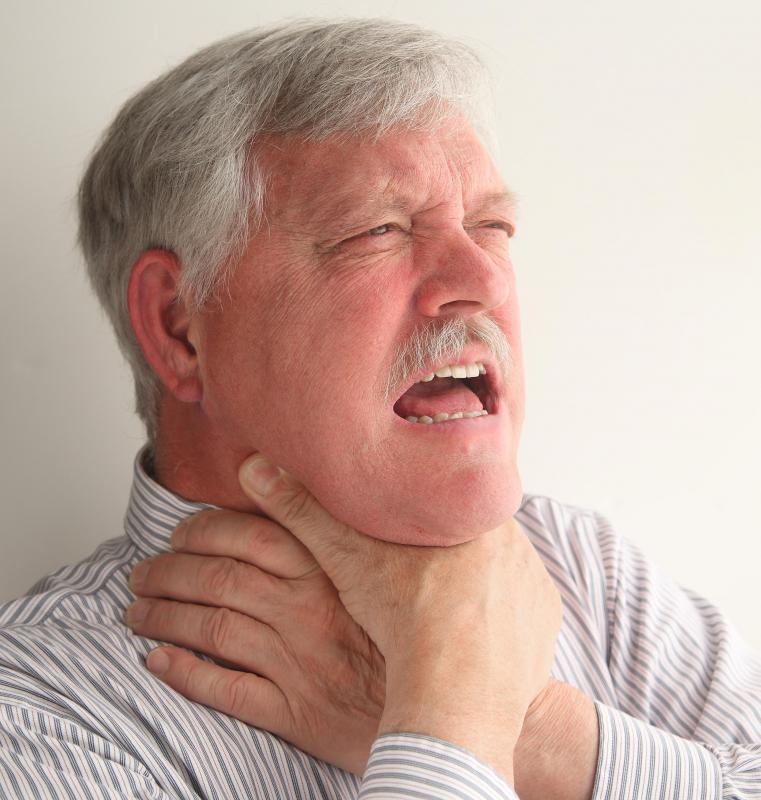At WiseGEEK, we're committed to delivering accurate, trustworthy information. Our expert-authored content is rigorously fact-checked and sourced from credible authorities. Discover how we uphold the highest standards in providing you with reliable knowledge.
What is an Asphyxiant?
An asphyxiant is an agent or event which induces asphyxia, also known as suffocation. Asphyxiation can be extremely dangerous, as lack of oxygen will kill most animals within minutes. Even if asphyxiation doesn't kill, it can result in severe brain damage. Therefore, asphyxiants are an issue of concern. Since asphyxiants can take a number of forms, it is an excellent idea to get acquainted with basic safety procedures which are designed to decrease the risk of asphyxia, ranging from learning to swim to using proper ventilation in laboratories.
Most people are familiar with an asphyxiant in the form of a event, like drowning or choking to death. In both of these cases, the asphyxiant renders the body unable to intake oxygen, leading to oxygen starvation. If the victim is removed from the asphyxiating circumstances, he or she should recover very quickly, as neither incident has health effects beyond asphyxiation.

In another sense, an asphyxiant can interfere with the body's ability to process and deliver oxygen. Carbon monoxide is an asphyxiant which acts in this way, by binding to the red blood cells of the body so that they cannot pass needed oxygen onto the rest of the body. In this case, the patient may need to be given pure oxygen or other treatments to force the carbon monoxide out of the blood, allowing him or her to recover normal oxygen circulation.

An asphyxiant can also cause suffocation by displacing oxygen in the environment. This type of asphyxiant takes the form of a gas such as helium, nitrogen, or argon. On their own and in small amounts, these gases are not harmful; in fact, you're breathing these gases right now. However, when concentrations of these gases get too high, they dilute oxygen levels to a dangerously low amount, and this will lead to asphyxiation.

Asphyxiant gases are a major issue because many of them are largely inert, and they are also odorless and colorless. Therefore, people may not be aware that they are in danger until it is too late. When working with asphyxiant gases, a well ventilated workspace is essential. This is especially true with liquid nitrogen, which will rapidly convert to gaseous nitrogen, overwhelming an environment very quickly. Excessive amounts of nitrogen will produce an oxygen-poor environment close to the ground, so if someone becomes unconscious and falls to the ground, his or her condition will rapidly get worse.
AS FEATURED ON:
AS FEATURED ON:
















Discussion Comments
Carbon monoxide is usually the first thing that pops in my mind when I hear "asphyxiant" also. But I just read a really disturbing article in the New York Times a few days ago about people who are committing suicide with homemade asphyxiants.
Apparently the instructions are posted online, which in itself is a little bit upsetting. Even worse, the gas can spread and harm other people in the area who don't have any desire to commit suicide. Also several rescue workers have been injured in asphyxiant gas related suicides.
I really think people posting those kind of instructions online should be held criminally liable. Suicidal people need help not instructions on how to kill themselves.
@indemnifyme - Oh wow. I'm glad your friend and his neighbors were all OK. Ever since I moved out on my own my Mom drilled the importance of having a carbon monoxide detector into my head.
I thought she was being a little over dramatic about it but after I did a little bit of research I found out that around a hundred people die from carbon monoxide poisoning every year in the United States! So I always make sure to have a working carbon monoxide detector in my home.
Asphyxiants are so scary. I actually have a good friend who almost died from carbon monoxide poisoning in his apartment building years ago.
He and his wife both got really sick with what they thought was a really bad flu one day. However when my friend left the apartment to go get something out of their car they happened to run into another neighbor that had the same symptoms they did.
My friend remembered the symptoms of carbon monoxide poisoning and started going door to door to see if anyone else was ill. Eventually he was able to get everyone out of the building and emergency medical services were called to treat them all.
After my friend told me this story I went out and bought a carbon monoxide detector the same day. I urge everyone else to do the same!
Post your comments